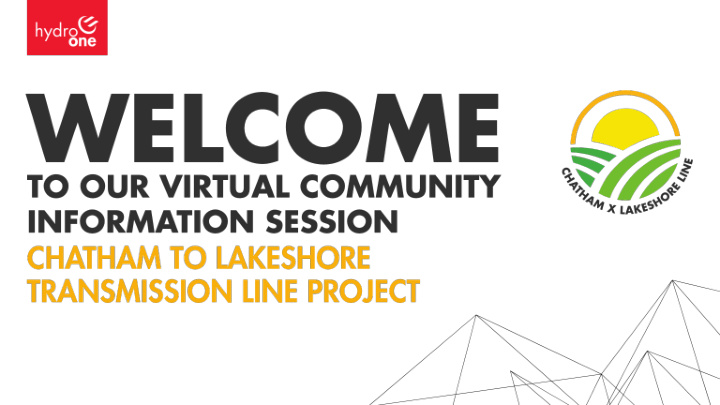



TODAY’S AGENDA • Project overview • Class Environmental Assessment process • Proposed route alternatives and route selection process • Key milestones and next steps • Live Q&A session 1
KEY ORGANIZATIONS Building infrastructure to meet the energy needs of today and tomorrow involves a number of partners, including: Builds, owns, operates and maintains electricity transmission and distribution facilities across Ontario. Oversees planning to ensure electricity needs are met both now and in the future. Legislative authority for environmental assessments in Ontario. Ministry of the Environment, Conservation and Parks Regulates the electricity market in Ontario, including electricity rates. 2
HOW THE SYSTEM WORKS 3
PROJECT OVERVIEW A safe and reliable electricity supply is essential to supporting economic growth, and as businesses and industry in southwestern Ontario continue to grow, so does the need for more electricity. To help meet this growth, Hydro One needs to build a new double circuit 230 kilovolt transmission line between our Chatham Switching Station and our future Lakeshore Switching Station, as requested by the Independent Electricity System Operator (IESO). This line will add 400 megawatts of power to the area – or enough power to energize a city the size of Windsor. This project requires a Class Environmental Assessment, where multiple route alternatives will be evaluated. It is anticipated this line will be in-service prior to the end of 2025. 4
WHAT IS A CLASS ENVIRONMENTAL ASSESSMENT? The Class Environmental Assessment (Class EA) for Minor Transmission Facilities sets out a planning and decision-making process for projects with predictable environmental effects that can be mitigated. KEY COMPONENTS • Consultation with Indigenous communities, community • Selection of a preferred alternative members, elected officials, interest groups and • A draft Environmental Study Report (ESR) that government agencies; will be made available for a 30-day public • Collection of environmental inventory; review and comment period; and • Identification and evaluation of alternative methods; • Submission of Statement of Completion and Final ESR • Identification of potential effects and mitigation measures; 5
HOW WE GOT HERE A preliminary assessment was conducted to map feasible route alternatives for the new transmission line. This involved mapping out known environmental and technical features, and identifying opportunities to parallel existing linear infrastructure and utilize existing easements, where possible. 6
ROUTES WE ARE STUDYING To view our interactive map, please visit: www.arcg.is/1PKL1n 7
EVALUATION OF ROUTES To evaluate the route alternatives, we will: • Meet with First Nations communities, community members, elected officials, and interest groups through Community Information Centres and engagement opportunities to gather feedback; • Conduct background research and detailed environmental field studies and technical assessments; and • Host a number of workshops with Technical Advisory Committee members. Based on the feedback and data collected, Hydro One will evaluate each route alternative based on a number of criteria. 8
EXAMPLE EVALUATION CRITERIA 9
LAND REQUIREMENTS Hydro One Real Estate coordinators have acquired temporary access from some landowners to conduct field studies as part of the Class EA process. Upon the selection of the preferred route, a Hydro One Real Estate coordinator will work with directly impacted property owners that will have a proposed structure or corridor on their property. Hydro One has a long history of building transmission projects and working in communities across the province. To guide our conversations with property owners, specific land acquisition principles based on our past experiences will be applied. 10
HOW TO GET INVOLVED Your feedback is important to us and we want to hear from you. You can provide us with your feedback by: Asking a question via our virtual community information session Submitting your comments to Community.Relations@HydroOne.com or 1-877-345-6799 Attending future Community Information Centres and other engagement opportunities To stay up to date on project details, please visit our webpage www.HydroOne.com/Chatham-to-Lakeshore 11
PROJECT MILESTONES 12
LIVE QUESTION PERIOD Panelists Daniel Levitan Sanjiv (Sonny) Karunakaran Vice President of Stakeholder Relations Director, Strategic Projects John Chadwick Sara Jane Souliere Manager, Environmental Services Senior Advisor, Indigenous Relations Andrew Luis Rouselle Gratela Senior Real Estate Coordinator Advisor, Regional and Community Engagement, IESO Kennan Ip Manager, Transmission Planning, IESO Please contact us at: View our interactive map: www.arcg.is/1PKL1n 13
Recommend
More recommend